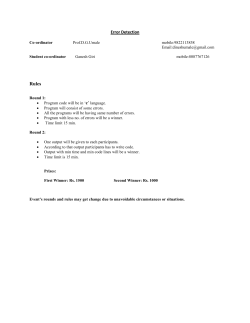
poster - Indian Institute of Science
Voting, Algorithms, and Complexity Palash Dey; Supervisors: Y. Narahari and Arnab Bhattacharyya; Indian Institute of Science, Bangalore, India. 14th International Conference on Autonomous Agents and Multiagent Systems Voting Applications Frugal Bribery Figure : Movie ratings Figure : Collaborative filtering Motivation Bribery in the setting where the briber is frugal in nature which is captured by her inability to bribe certain types of voters. Vulnerable votes Let v1, · · · , vn be a set of voters which makes some candidate x win. Let y be another candidate. A voter vi is called y -vulnerable if vi prefers y to x. Frugal-bribery Given a set of votes and a candidate y , does there exist a way to change the y -vulnerable votes that makes y win? Frugal-$bribery Given a set of votes, a candidate y , costs of y -vulnerable votes, and a budget B, does there exist a way to change some of the y -vulnerable votes subject to budget constraint B that makes y win? Key Results We show that two problems are intractable for many common voting rules. Kernelization for Possible Winner Figure : Search engine Figure : Crowd sourcing Voting Setting • V - a set of n voters. C - a set of m candidates. • Complete vote - a complete order over C . L(C ) - set of complete orders over C . • Partial vote - a partial order over C . • Voting rule - r : L(C )n −→ C . ¯ = (α1, · · · , αm) ∈ Rm. Scoring rule : Defined by α Candidate ranked at i th position gets score αi . Winner is the candidate with highest score. ¯ = (m − 1, m − Borda rule : Scoring rule with α 2, · · · , 1, 0). Maximin rule : Winner is the candidate with minimum margin of victory in its worst pairwise election. Copeland rule : Winner is the candidate with maximum pairwise wins. Bucklin rule : Winner is the candidate getting majority within minimum number of top positions. Margin of victory - smallest number of vote changes required to change winner. Thesis Overview Thesis: Voting, Algorithms, and Complexity Election Manipulation Partial Information Manipulation detection [AAMAS 2015] Kernelization for Possible Winner [AAMAS 2015] Frugal bribery Manipulation under partial information Prediction Algorithms Winner prediction [AAMAS 2015] Possible Winner Given a voting rule r , a set of partial votes P, and a candidate c, does there exist an completion of the partial votes in P to linear votes that makes the candidate c win the election. Coalitional Manipulation Given a voting rule r , a set of complete votes P corresponding to the votes of the non-manipulators, a non-empty set of manipulators M, and a candidate c, does there exist a way to cast the manipulators’ votes such that c wins the election. Question What are the kernelization complexity of above problems? Key Results The Possible Winner problem does not admit a polynomial kernel where as the Coalitional Manipulation problem admits a polynomial kernel. Manipulation under Partial Information Motivation Manipulators usually have only partial knowledge about the truthful votes. Weak Manipulation Given a voting rule r , a set of partial votes P corresponding to the votes of the non-manipulators, a non-empty set of manipulators M, and a candidate c, does there exist a way to cast the manipulators’ votes such that c wins the election in least one extension of the partial votes in P. Strong Manipulation Given a voting rule r , a set of partial votes P corresponding to the votes of the nonmanipulators, a non-empty set of manipulators M, and a candidate c, does there exist a way to cast the manipulators’ votes such that c always wins the election in every extension of the partial votes in P. Key Results Manipulation becomes intractable for most of the voting rules in this setting. Winner Prediction Motivation Margin of victory estimation [IJCAI 2015] Manipulation Detection Motivation Coalition of possible manipulators: Given an r -election, a subset of voters M ⊂ V is a CPM if there exists 0M such that: r (M , V \M ) 0M r (0M , V \M ) We call r (0M , V \M ) the actual winner Problem Formulation Input: election M ⊂ V given. Question: is M a coalition of possible manipulators? Find: a coalition of possible manipulators M with |M| = k. Actual winner given: CPMW Actual winner given: CPMSW Actual winner not given: CPM Actual winner not given: CPMS Key Results We study computational complexity of above problems for various voting rules. For the Borda voting rule, the results are very promising. Borda: manipulation is NPC. Borda: Detecting manipulation is easy. Predicting the winner of an election is a basic problem in social choice theory. We study the sample complexity of this problem. (ε, δ)–Winner determination Given a voting rule and a set of n votes over a set of m candidates such that the margin of victory is at least εn, determine the winner of the election with probability at least 1 − δ. Results We obtain tight upper and lower bounds on the sample complexity for winner prediction. Our results show that the winner can be predicted quite accurately by sampling only a few votes. Margin of Victory Estimation Motivation In polling, surveys, and audits, the sample size depends on the margin of victory of the election. Hence, given an election, we need to estimate its margin of victory. (c, ε, δ)–Margin of Victory Given a r -election E, determine margin of victory (MoV), the margin of victory of E with respect to r , within an additive error of at most c · MoV + εn with probability at least 1 − δ. Results We obtain tight upper and lower bounds on the sample complexity for estimating margin of victory. Our results show that the margin of victory of an election can be estimated quite accurately by sampling only a few votes.
© Copyright 2025







![Dear [Candidate]: Thank you for your willingness to stand for](http://cdn1.abcdocz.com/store/data/001026053_1-7f0c5dc0a9066cdd4178856527c082aa-250x500.png)

